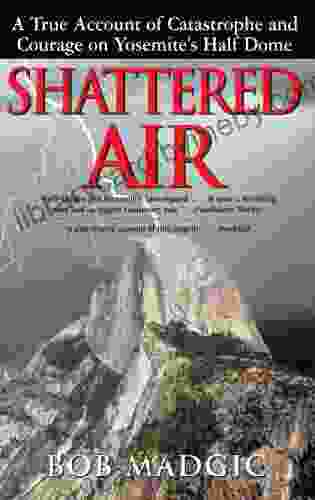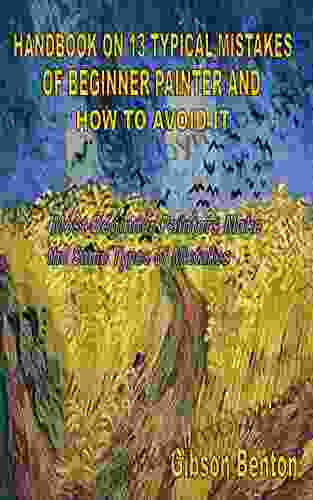Most Beginner Painters Make The Same Types Of Mistakes

: Embarking on the Artistic Odyssey
The world of painting is an enchanting realm where imagination takes form on canvas. For aspiring artists, the journey of wielding brushes and colors can be exhilarating yet daunting. Like any endeavor, painting presents its challenges, and for beginners, there are common pitfalls that can hinder their progress.
This comprehensive guide aims to illuminate these pitfalls, providing invaluable insights and guidance to help novice painters avoid these obstacles, cultivate their skills, and embark on a successful artistic journey. By understanding the reasons behind these errors and embracing effective techniques, aspiring artists can paint with confidence, unleash their creativity, and create captivating masterpieces.
4.3 out of 5
| Language | : | English |
| File size | : | 1806 KB |
| Text-to-Speech | : | Enabled |
| Enhanced typesetting | : | Enabled |
| Print length | : | 15 pages |
| Lending | : | Enabled |
| Screen Reader | : | Supported |
Identifying the Most Common Mistakes Made by Beginner Painters
1. Lack of Patience and Rushing the Process
Enthusiasm and eagerness are commendable traits in any endeavor, but when it comes to painting, patience is paramount. Rushing the process can lead to unsatisfactory results and undermine the overall quality of the artwork. Beginners often attempt to complete paintings quickly, resulting in uneven brushstrokes, poorly blended colors, and a lack of attention to detail.
To overcome this pitfall, it is crucial to slow down and approach the painting process with patience and care. Allow sufficient time for each layer of paint to dry, carefully blend colors to create smooth transitions, and pay meticulous attention to细节,以创造出引人注目的作品.
2. Insufficient Color Mixing and Understanding
Color theory plays a fundamental role in painting, and understanding the principles of color mixing is essential for creating harmonious and visually appealing compositions. However, many beginner painters struggle with mixing colors effectively, resulting in muddy or dull hues that fail to convey the desired impact.
To master color mixing, it is recommended to experiment with different color combinations and proportions. Practice mixing primary and secondary colors to create a comprehensive range of shades. Pay attention to the temperature and saturation of colors, as these factors influence the overall mood and tone of the painting.
3. Neglecting the Importance of Composition
Composition is the arrangement of elements within a painting and is crucial for creating a balanced and visually pleasing image. Beginner painters often overlook the importance of composition, resulting in artworks that lack focus, coherence, and impact.
To enhance composition, consider the rule of thirds, which divides the canvas into thirds both horizontally and vertically. Place key elements along these lines or at their intersections to create a visually engaging arrangement. Additionally, experiment with different perspectives, cropping techniques, and leading lines to guide the viewer's eye through the painting.
4. Overworking the Canvas
The desire to create a flawless painting can sometimes lead beginner painters to overwork the canvas. Excessive layering of paint, repeated blending, and constant adjustments can result in a loss of vibrancy, texture, and depth.
To avoid overworking, learn to embrace the imperfections and variations that occur during the painting process. Trust in your initial brushstrokes and allow them to contribute to the character and charm of the artwork. Step back from the canvas periodically to assess the overall composition and make deliberate choices about where and when to add additional layers.
5. Ignoring the Significance of Value and Contrast
Value refers to the lightness or darkness of a color, and contrast is the difference in value between two areas of a painting. Proper understanding and use of value and contrast are essential for creating depth, dimension, and visual interest.
To effectively incorporate value and contrast, study the subject matter carefully and identify the lightest and darkest areas. Gradually transition between these values to create a sense of depth. Experiment with high-contrast compositions to accentuate certain elements or draw attention to specific focal points.
Additional Tips for Beginner Painters
- Start with small, manageable paintings to build confidence and avoid overwhelming yourself.
- Invest in quality brushes and paints. Good tools make a significant difference in the outcome.
- Practice regularly and experiment with different techniques to develop your skills.
- Seek inspiration from other artists, attend workshops, and study art history to broaden your knowledge.
- Don't be afraid to make mistakes. They are opportunities to learn and grow as an artist.
- Join a painting community or connect with other artists for support and feedback.
: Embracing the Journey and Cultivating Artistic Excellence
The pursuit of painting is a journey filled with both challenges and rewards. By understanding the common pitfalls faced by beginner painters and embracing the guidance provided in this article, aspiring artists can avoid these obstacles, cultivate their skills, and embark on a path towards artistic excellence.
Remember, patience, practice, and a willingness to learn are the keys to unlocking your artistic potential. Embrace the journey, embrace the mistakes, and never cease to explore the boundless possibilities that lie on the canvas.
With dedication and a passion for creating, you will undoubtedly overcome these common pitfalls, develop your unique style, and leave your mark on the world of art.
4.3 out of 5
| Language | : | English |
| File size | : | 1806 KB |
| Text-to-Speech | : | Enabled |
| Enhanced typesetting | : | Enabled |
| Print length | : | 15 pages |
| Lending | : | Enabled |
| Screen Reader | : | Supported |
Do you want to contribute by writing guest posts on this blog?
Please contact us and send us a resume of previous articles that you have written.
 Book
Book Novel
Novel Page
Page Chapter
Chapter Text
Text Story
Story Genre
Genre Reader
Reader Library
Library Paperback
Paperback E-book
E-book Magazine
Magazine Newspaper
Newspaper Paragraph
Paragraph Sentence
Sentence Bookmark
Bookmark Shelf
Shelf Glossary
Glossary Bibliography
Bibliography Foreword
Foreword Preface
Preface Synopsis
Synopsis Annotation
Annotation Footnote
Footnote Manuscript
Manuscript Scroll
Scroll Codex
Codex Tome
Tome Bestseller
Bestseller Classics
Classics Library card
Library card Narrative
Narrative Biography
Biography Autobiography
Autobiography Memoir
Memoir Reference
Reference Encyclopedia
Encyclopedia Teh Chen
Teh Chen Bette Howland
Bette Howland Jessica L Roberts
Jessica L Roberts Betty Arnett
Betty Arnett Cynthia Lord
Cynthia Lord Bob Langert
Bob Langert Joseph Conrad
Joseph Conrad Gail Gross
Gail Gross Bob Gaines
Bob Gaines Brad Klontz
Brad Klontz John Roosa
John Roosa Bill Clegg
Bill Clegg Billy Merritt
Billy Merritt William Zinsser
William Zinsser Bernadette Von Dreien
Bernadette Von Dreien Dorothy Allison
Dorothy Allison Bo Eason
Bo Eason Bill Ingersoll
Bill Ingersoll Beth Zasloff
Beth Zasloff Jeffrey Scott
Jeffrey Scott
Light bulbAdvertise smarter! Our strategic ad space ensures maximum exposure. Reserve your spot today!
 Damon HayesFollow ·11.9k
Damon HayesFollow ·11.9k Jedidiah HayesFollow ·2.5k
Jedidiah HayesFollow ·2.5k Bradley DixonFollow ·17.1k
Bradley DixonFollow ·17.1k Thomas PynchonFollow ·18.2k
Thomas PynchonFollow ·18.2k Yasunari KawabataFollow ·15.8k
Yasunari KawabataFollow ·15.8k Edgar CoxFollow ·2.4k
Edgar CoxFollow ·2.4k Jerome BlairFollow ·14.8k
Jerome BlairFollow ·14.8k George MartinFollow ·19.7k
George MartinFollow ·19.7k

 Ivan Cox
Ivan CoxSpeak With Ease: The Ultimate Guide to Public Speaking...
By Rupika Raj ...

 Jesus Mitchell
Jesus MitchellVulcan Forge: A Suspense Thriller that Will Keep You on...
Vulcan Forge is...

 Dashawn Hayes
Dashawn HayesThe Carteret Family Bob Martin: A Comprehensive Review
Bob Martin's...

 Owen Simmons
Owen SimmonsUnlock the World of Cultural Nuances with "The Global...
Embark on a Journey of...

 Ian McEwan
Ian McEwanConquer the Mountain: True Account of Catastrophe and...
In the heart of California's stunning...
4.3 out of 5
| Language | : | English |
| File size | : | 1806 KB |
| Text-to-Speech | : | Enabled |
| Enhanced typesetting | : | Enabled |
| Print length | : | 15 pages |
| Lending | : | Enabled |
| Screen Reader | : | Supported |














